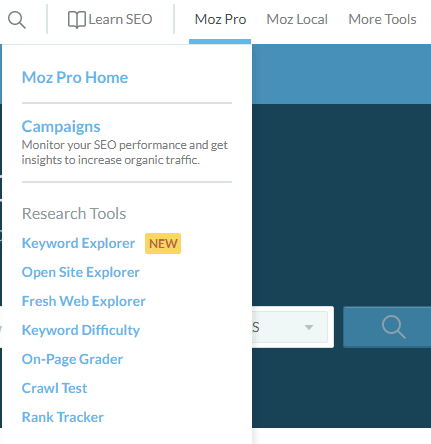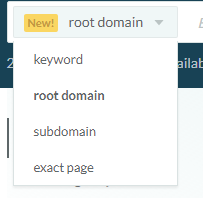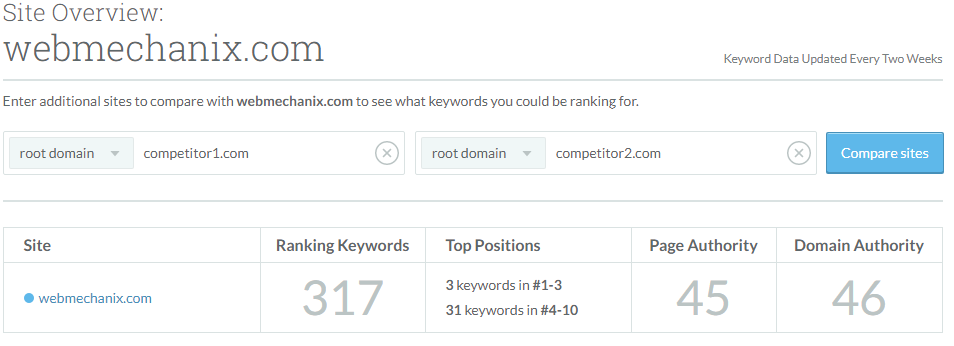
These Competitor Analysis SEO Tools Will Make You the James Bond of B2B Content Marketing
– Exclusive “Peek Behind the Curtain” Series –
Many companies are missing out. They’re completely unaware of what their competition is doing. Are you one of them? If so, it doesn’t have to be this way…
Too many companies are doing the exact, same keyword research others have already done. They mistakenly target under-performing audiences that competitors have already tried. And rarely, do they peek out the window at what a their neighbors are doing.
Don’t waste another dime on initiatives doomed to fail. You don’t have to.
The truth is that this blind approach leaves a pile of money on the table. You may as well throw a stack of lit matches onto your cash and watch it burn.
Especially for B2B SaaS companies, a highly competitive space that we happen to specialize in, knowing what other companies are doing can save hours of time and tons of money. This is because there are weird, long, niche phrases or ad copy ideas that go unnoticed all the time in the research and creative process.
In this series, called “Peek Behind the Curtain”, I’m going to show you how to spy on your competitors’ keywords, content, and PPC campaigns. You will be able to identify what’s working quickly and save yourself countless hours toiling away at figuring out how to one-up all your competitors.
I’ll also give some brutally honest info on which PPC and SEO spy tools are actually worth your time (we’ve tested just about all of them).
This is the first part of the series, where we will be focusing on competitive analysis SEO tools.
Why Competitor Analysis Even Matters

Studying competition has been a practice since the dawn of time. We record world history and technological discoveries so we don’t have to repeat the same experiments and so that humanity as a whole can progress.
Top business leaders do the same thing.
Steve Jobs, founder of Apple (currently the largest market cap company in the world), has said numerous times that he shamelessly steals ideas:
James Sinegal, founder of Costco, and Sam Walton, founder of Walmart, two of the most successful companies of the last century, have said the same thing.
“Most everything I’ve done I’ve copied from someone else.”
-Sam Walton, from his book, Made in America
Why waste thousands of dollars and months of time testing the same keywords, targeting, and ad ideas when you can legally see what’s worked for your competitors?
Wanna know how? Read on, friend……
A Peek Behind The Curtain of SEO Competitor Analysis

Here is a breakdown of the top competitor analysis tools we recommend:
Moz
After promising this to customers for years, Moz has finally rolled out its own website competitor analysis tool. They claim it took a while because they wanted it to be more accurate than the others.
Once you purchase Moz Pro, login, click the “Moz Pro” drop down menu, and select “Keyword Explorer.”

You will be taken to the Keyword Explorer tool. From here, there is a drop-down menu on the left-hand side of the search bar. You can select the “root domain”, “subdomain”, or “exact page” option for what type of URL you want to check.

Choose one of these options. Then, enter an URL from your site or a competitor’s site you want to check. I suggest just starting with the root domain.
Press the Magnifying glass icon to search and it will give you some date. From here, you can enter in two other URLS to compare this domain to at the top. Enter the URLS and press the “Compare sites” button.

From here, Moz will give you all the ranking keywords you have, split by if they rank in the Top 3, Top 10, 20 to 30’s, 30’s to 40’s, and so on.
If you select the “See all ranking keywords” option, you get even more details. You get a Venn Diagram that tells you which keywords you share with your competitors.
How is this useful? Use this to identify hot keywords everyone is gunning for that you failed to prioritize or even notice.
Below this Venn Diagram is a table. You can sort by the top ranked keywords of any of the URLs, Difficulty score, or Monthly Volume. This is a good area to find out keywords your competitors are ranking for already that you haven’t considered creating content to outrank them.
BuzzSumo
There are a lot of social content acrobatics you can do with BuzzSumo. But today, we are going to be focusing on one in particular: reverse engineering topics, titles, and articles that work.
Why waste your time shooting in the dark when there are hundreds of millions of tested articles out there right now to draw data from today?
BuzzSumo sorts and organizes the social shares around the articles in the web into category or queries of your choice.
After logging in, make sure the “Most Shared” tab is selected. Then, enter your competitor’s domain into the search field. BuzzSumo lets you sort by which articles on your competitor’s site have gotten the most social shares.
You can even click on a specific column heading (e.g. “Facebook Engagements”) to sort by a specific social platform’s shares. I suggest sorting by the main platform that caters to your industry because counting the other platform’s shares may be irrelevant.
For example, if you’re in a more visual industry, like cooking or fashion, sort by Pinterest shares. If you operate in the B2B space, I’d suggest LinkedIn, although Facebook has been gaining good traction lately, too.
Get keyword or topic ideas
Now, look at which topics are getting the most attention. These topics are likely going to be the ones that get the most search traffic, but not always. A topic that can get a lot of love on social even though it isn’t searched much.
Use these topics as inspiration for finding the next money-making, niche keyword. Or you can leverage these as article topics even if you can’t find substantial search volume. This is because the article could still get a lot of traction and a majority of search traffic are long-tail keywords that don’t get picked up by Google’s Keyword Planner (you could be sitting on an SEO pot of gold).
Get blog topic ideas to get more click-throughs.
One easy way to increase the click through rate on your article from social media and/or Google is to identify time-tested formulas that are working. While listicle or clickbait style formulas may seem like they’re beaten to death, they are still used for a reason — they work.
With Buzzsumo you can enter a topic or competitor’s domain, and you will find other headline styles that have proven to get the most social shares in your industry. Some of these are very innovative and you may have not even considered using.
Get content format and writing style ideas
SEO these days has become more all-encompassing. It’s not only about keywords anymore. It’s about creating the best content possible that serves reader effectively.
These readers send positive signals to Google in the form of bounce rate, time on page, and social metrics.Google uses these love notes about your page to rank you higher (or lower).
One part of that is developing a great writing style and understanding good content structure to keep users reading and engaged with your post (which may increase average time on page, lower bounce rate, etc.).
Therefore, click into a few of the top articles you see in BuzzSumo. Study how their content is structured and how the article flows.
Is it an infographic? Is it an article? How thorough is the article? Is it long-form or short-form? How does the writer keep you engaged? Do they use visuals? How many pictures do they use and what type of pictures are they (memes, Instagram embed, etc.)? Is it a listicle or an essay?
Look for patterns
Look for common patterns among the top content. Is there a specific formula they use for headlines (e.g. “You Won’t Believe …. “ or “Top 10…”)? Do they always hook you in with the first line of the sentence with a curiosity-provoking statement?
These patterns will help you find the right recipe for success, duplicate it and iterate to create content that attracts more and more traffic.
Pricing
BuzzSumo has three main pricing tiers that range from $79 a month to $239 a month. You can find out more here.
How to do it for free
If you’re on a budget and want a free SEO competitor analysis tool, then BuzzSumo may be a good choice to mine ideas for keywords and topics. Articles that are shared the most usually also have a lot of search volume demand (though not always).
BuzzSumo offers a free, though severely restricted, plan. You get a few free searches a day. Good news, this may be enough for a small organization looking to bootstrap.
SEMrush and Ahrefs
Use SEMrush and Ahrefs if you want the best competitor analysis in SEO.
Why are these the best? They’re intuitive, they’re accurate, and they’re the most thorough.
These tools are highly focused on SEO rather than AdWords PPC. Therefore, if your main or only focus is SEO competitor analysis, these tools may be better for you because they go into more detail and provide more accurate, comprehensive metrics.
They are both very similar.
Out of all the keyword spy tools mentioned, I think SEMRush is the best for this type of spying.
Their platform is fast. And it doesn’t take multiple clicks or a lot of waiting to find what you need. You simply put any URL into the search bar and it will give you all the keywords that a page ranks for. Plus, the keywords they give you are substantially more thorough and accurate compared to SpyFu.
I’ve done tests using SpyFu, and it will miss out on many keywords a page is ranking for or only show a small slice of what they’re ranking for and claim that this is everything.
SEMRush, though not perfect, is much more robust.
One useful metric SEMrush provides is the search volume and position for every keyword a competitor ranks for. You can find this by logging into the tool, entering a competitor’s domain into the search bar, pressing “Search”, and then clicking the “Organic Research” subtab on the far left.

We love SEMRush the most for these reasons:
- There is a Phrase Match Tool under Keyword Analytics that gives keyword suggestions and metrics based on the keyword you enter.
- You can set up numerous filters to sort by what a keyword contains, the number of keywords in a phrase, the difficulty, the competition, or the search volume. It also has filters for keyword “Contains”, “Does Not Contain”, “Begins”, and “Ends With”.
- The most accurate, thorough data on keywords competitors’ rank for — great for stealing SEO ideas from.
- Extensive Backlink Profile information, which includes what % of links are text vs image vs form, source country percentage breakdown, and what % are follow vs nofollow. This can also be super helpful in determining how much focus your competitors are actually putting on SEO.
One useful metric Ahrefs provides is the history of a site’s estimated organic traffic over time. Similarweb.com gives you this for free, but Ahrefs provides a more accurate number.
Try out SEMRush for free yourself by entering in a URL or keyword below. Full disclosure: If you try out SEMRush through the tool below and decide to purchase, we get a commission at no extra cost to you.
SpyFu
This will be no surprise by now, but SpyFu is the last tool I would turn to for SEO competitor analysis.
Despite its drawbacks, it still has strong benefits. It is a great tool for getting all the juicy keywords you didn’t even think of from your competitors but doesn’t provide the most accurate results. You get time-tested keywords that they have already proven to get a lot of traffic for.
Specifically, here’s what I suggest you do in SpyFu for SEO competitor analysis…
Log into SpyFu. Click the SEO Research tab. Click the SEO Keywords subtab.
Enter the competitor URL in the search bar (it can be the main domain or a specific page). From here, SpyFu will provide many metrics on the SEO performance of the URL.
Pay particular attention to:
- Which relevant keywords they rank well for on Google (for the main domain or a specific page).
- Which relevant keywords they are close to getting on the first page for.
- Which relevant keywords they get the most traffic from.
- Which keywords recently rose or dropped in rankings.
Now that you have these new keyword ideas, they can be added to existing content for SEO or future content to target unexplored or ignored keyword topics. In turn, this will help you attract more customers – a win-win situation.
Also, you can even use these SEO keywords as AdWords keyword targeting ideas. It’s important to share ideas between your AdWords and SEO initiatives so that you pick up on keyword trends you might otherwise miss. We’ll talk more about this in the AdWords competitor analysis post.
Track Ranking History of a Keyword
Interested in seeing how a keyword you’re competing for has changed in ranking for you versus your competitor(s) over time? SpyFu has you covered.
Click the “Ranking History” subtab under the “Keyword Research” tab. Then, enter the keyword you’re interested in.
On the left hand side, you can add domains of your competitors and/or your own domain to compare.

SpyFu lets you see how your rankings have changed in the last 6 months, one year, two years, five years, or all time. Keep in mind that this ranking history isn’t 100% accurate. It is SpyFu’s estimate.
Pricing
SpyFu is a paid monthly product. They offer three tiers of pricing options that range in price from $33 a month to $299 a month. Find out more here.
Conclusion
You are being left behind if you’re not analyzing the social and SEO tactics of your competitors.
Effectively using competitor analysis tools can give you a thorough, realistic understanding of the landscape online. That doesn’t mean all of their ideas are effective, but it’s better to be in the know than left in the dark.
We’ve used these SEO competition tools for our clients and uncovered surprising insights. Offline leaders weren’t always doing as well as we thought online. And new online competitors were dominating in ways we weren’t aware of.
Without making a conscious effort to keep tabs on others, you can fall behind, miss great keyword opportunities and ad ideas, or be overtaken by a site you weren’t even aware of.
Stay tuned for the next two blog posts in this “Peek Behind the Curtain” series on competitor analysis.
Are there any competitor insights you really care about? Did I miss anything? Let me know in the comments.
Let Us Do It For You
Here at WebMechanix, we’re experts in conversion rate optimization, PPC, search engine optimization, B2B content marketing strategy, and social media competitive analysis.
For a free, no obligation audit, click here to contact us now.
Complement Your Competitor Analysis SEO Tools with These 7 B2B Marketing Ideas →
View all posts filed under “SEO” →
Back to the main blog overview →
Return to WebMechanix.com homepage →
Most newsletters suck...
So while we technically have to call this a daily newsletter so people know what it is, it's anything but.
You won't find any 'industry standards' or 'guru best practices' here - only the real stuff that actually moves the needle.






